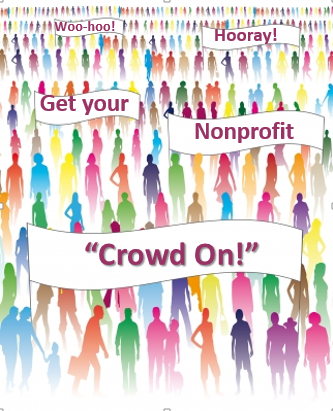 I’ve been thinking a lot about crowdfunding lately.
I’ve been thinking a lot about crowdfunding lately.
Bzz… bzz… buzz… buzz… Do you hear it?
It’s the sound of the times. It’s the bees flying around crowdfunding campaigns like honey. Sweet, golden honey.
Are you getting yours?
With the mainstream shift into digital communication, and the advance of technology through online donation and peer-to-peer fundraising platforms, crowdfunding is something I believe you should seriously consider if you’re not already getting your “crowd” on.
Especially if you have…
- A big campaign going on.
- Or a specific project that lends itself well to the telling of a compelling story.
- Or you need to raise a lot of funds in a relatively short time period.
- Or there’s a strong tie to some big event – anniversary; holiday; news story.
- Or your current constituents are more inclined towards being ambassadors than asking or giving.
- Or you’re having a hard time breaking out of the “box” of folks you think might be interested in your cause, and are looking to build your audience in new ways.
So I’ve put together a few resources, and some of my own thoughts, to help you think things through.
What the Heck is Crowdfunding?
The simplest definition is “online social fundraising.”
There are crowdfunding platforms and these enable virtual peer-to-peer fundraising. One is a tool; the other is the activity that uses that tool.
Crowdfunding, like any other fundraising activity, begins with (1) a story and (2) a community with whom you plan to share that story.
Then you need (3) a campaign hub (this will usually be your website) amplified by some (4) tools to help you seamlessly administer the campaign.
While features differ from site to site, crowdfunding platforms are websites that allow you to set up an online fundraising campaign based around a targeted fundraising page; then accept money directly from that page using the website’s own credit card processor.
Many crowdfunding sites will also allow supporters to set up individual fundraising pages on your behalf; others will allow you to set up a master campaign page while your supporters set up tangential pages they can use to get their friends to donate towards your overall campaign.
There are both nonprofit-specific sites and other sites that are used by nonprofits, individuals and start-up businesses alike. Take a look at some options here.
Why You Should Get Your “Crowd On” Now
There’s a lot of money in crowdfunding.
Peer-to-peer fundraising is easier and more accessible than ever.
This is why many nonprofits are making it a key component of their overall fundraising strategies.
- It creates broad awareness of your cause.
- It reaches folks you’d otherwise not reach.
- It’s cost-effective.
- It’s easy.
- And it works.
Of course, like every other strategy on earth, it only works if you do it right.
More and more nonprofits are learning the ropes and reaping the rewards. You don’t want to be left behind.
Need help persuading your leaders this is something you should embrace? Check out the data below, put together by Craig Newmark’s craigconnects:
Crowdfunding Puts You in Control
Social media expert Justin Ware describes most online fundraising strategy as “sit back and wait.”
Crowdfunding is different. It’s an active online giving strategy.
Think about it.
Folks see your “Donate Now” buttons out of the corner of their eye most of the year. Too often your calls to action blend in so well with your site colors and design that they fade into the background. Even if they’re big, bold and hard to miss, they still too often take folks to a generic, rather uninspiring giving page. And I’ll bet you’re not doing much to drive folks to your giving pages.
Sadly, most online fundraising is still relatively passive.
Crowdfunding is different. It leverages social media.
It speaks to the growing numbers of people who are online – in many different places – much of the day.
The bottom line is, lots of people are online every day. Many of them have come to expect dynamic, real-time engagement with online platforms. And the passive fundraising tactic of planting a static giving form at the backend of a “Give Now” button simply doesn’t match the dynamic, real-time expectation of donors. – Justin Ware
Want to match the expectations of your potential donors for a dynamic experience that offers immediate gratification?
Here are a few ways to get up to speed.
Crowdfunding 101
First, this week I had the pleasure of hosting guest presenter, Dana Ostomel, for a free “Crowdfunding 101” webinar. If you weren’t able to attend the live presentation, you can listen to the recording here.
Crowdfunding Tips
Second, Rob Wu and Sara Choe, CauseVox put together a handy list of five tips to help you get your mind around what successful crowdfunding entails. In brief, they are:
- Use compelling storytelling
- Create a fun challenge (the article has examples; another would be something like the Ice Bucket Challenge)
- Integrate peer-to-peer fundraising (this means providing multiple ways for folks to plug into your campaign, like personal and/or team fundraising pages)
- Get endorsements from social media influencers
- Use fundraising perks and rewards carefully
Think of it this way:
“Crowdfunding for nonprofits is like a good party. It tells a great story; it’s fun, it’s open and easy to invite others, it’s well-amplified and offers a nice token of appreciation to its guests.”
Crowdfunding Stats
Third, I found a research study on the IndiGoGo Blog with 7 Stats from 100,000 Crowdfunding Campaigns. It seems like a good place to check out what’s working/what’s not working. Here, in brief, are the suggested “to-do’s”:
- 30 day campaigns work best.
- Continually update your campaign page after launch.
- Start and finish strong. 42% of funds are raised in the first and last 3 days of the campaign’s duration.
- Add new perks after your launch to incentivize people to contribute.
- Work with a team. You’ll raise three times as many funds as campaigners who choose to work solo
- Include a pitch video. You’ll raise four times more funds than campaigns without one (Note: Per Razoo, in the infographic above, you’ll raise two times as much — still more!).
- Maximize your reach. Don’t forget that crowdfunding enables you to reach the entire world.
I found more great research on the Fundly Blog, with some interesting statistics you can use to persuade your ‘powers that be’ it may make sense for you to go in this direction:
- Donation crowdfunding is the 2nd largest type of crowdfunding.
- Crowdfunding has become one of the most popular ways for individuals to raise money for a cause, project, or event
Crowdfunding and Social Media
Fourth, I really enjoyed a recent article from the folks at Krowdster: Top 4 Crowdfunding Mistakes on Social Media. I’d like to offer a quick summary so you know the types of issues you should be considering.
- Make sure you begin with a strong social media following before launching a campaign. You can use Krowdster’s Social Capital Gauge to measure the size of your Twitter and Facebook following and find out how much other campaigns with similar social reach have raised.
- It’s not just the following; it’s the list, stupid. Just like any other fundraising strategy, who you message is more important than what or how you message. A big social media list of folks who have little to no interest in what you do is going to do you absolutely no good when you run a crowdfunding campaign.
- Cultivate before you ask. Online crowds are no different than offline crowds. It’s all about building relationships. Virtual strangers are unlikely to give you money. So “preview” your campaign (which most crowdfunding platforms easily enable) and collect feedback before you launch into your solicitation.
- Work it.
If you’ve ever used Twitter you know how fast and furious the tweets arrive. It’s easy to miss a lot of good ones. This means you can’t just send out one tweet and think you’ll get much action. You have to have a plan that enables tweeting several times per day, every day. For Facebook Krowdster recommends posting no more than once every 1-3 days depending on the size of your audience. Keep messages fresh and fun. Continually show folks the impact of their giving. Report on campaign progress to keep momentum flowing.
SUMMARY: 15 Ways to Play to the Crowd
In many ways, crowdfunding requires you do to what you should always do — but too often you don’t. Take these 15 tips to heart and your next campaign (crowdfunded or otherwise) will be “in the money”:
- Make sure you have a good constituency with whom to share your campaign.
- Make sure you have a compelling case for support (a great story!) that resonates with your constituency.
- Create a strategic campaign plan that integrates awareness and relationship building with fundraising.
- Have a specific dollar goal.
- Have a specific project goal.
- Ask for a specific amount.
- Make your messaging clear, consistent and catchy.
- Take advantage of trends that serve as “short-cuts” to grabbing attention (e.g., storytelling, video and other visuals).
- Make your campaign easy to manage.
- Involve your entire organization; we’re all in fundraising now.
- Make it easy for donors to give.
- Make it easy for donors to share.
- Build a community of champions willing to spread your message.
- Leverage press to get campaign publicity.
- Follow up and make your influencers and donors feel great.
It’s a crowded marketplace in our digitally connected world. You owe it to yourself to explore the different ways you may be able to simultaneously play to the crowd and stand out from the crowd.
If there were ever a time to stop thinking of fundraising and marketing being two separate things, crowdfundraising is the time to STOP. Please, just stop!
Crowdfunding is all about marketing.You grab someone’s attention in a few seconds, you offer your compelling call to action, and you make it easy for them to answer right away.
Give this some thought as you plan ahead for next year’s integrated fundraising/marketing campaigns.
If you’re doing any successful crowdfunding campaigns, please share with me and others. We learn from each other!







“Crowdfunding is different. It’s an active online giving strategy.”
THIS. I think the problem that most people have is thinking that you can put up a campaign on a crowdfunding site and just wait for the money to come in. Be active. Don’t give people the impression that all you care about is getting money from them. Thank people for their donations. Update them on how your project is going, write more about yourself or organization’s goals, keep telling stories! As you mentioned, we’re used to the internet and social media being interactive, not static….a little effort can go a long way.
-Jodi